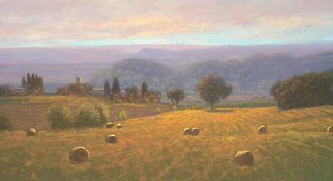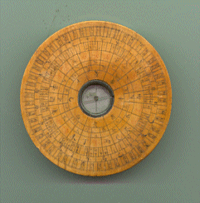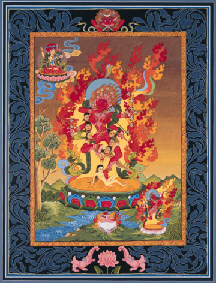An articel about the recent Election...

By A T Mann
In the late 1970s my Italian partner in our London publishing company moved back with his family to the Tuscan town of Montalcino, near Siena. Giugi loved drinking wine and indeed had wine to thank for his house, which was a priest's house abutting a deconsecrated church, complete with abandoned outbuildings and a ruin of one of the picturesque six-hundred-year-old towers that had once protected the city of Siena.
Wine Musings
By A. T. Mann
I lived in England for almost twenty years throughout the 1970s and 1980s, and during that time observed and participated in many rituals involving the drinking of fantastic wines of various types. Although the English are not usually thought of as being “into” fine wine, they most definitely are, especially in recent decades, and particularly amongst their "upper" classes.
The Roof of Europe — Alp Action
ATMann's wrote a series of short essays for The Roof of Europe, a book I helped create with the environmental fund Alp Action, founded by Prince Sadruddin Aga Khan. It was published in 1990 by the Bellerive Foundation in Geneva, Switzerland. The essays are the involvement with mountains and specifically the Alps by Carl Jung, Herman Hesse, Thomas Mann, Percy Shelley, Nietzsche, J.M.W. Turner, Conan Doyle and the Alchemists. The foundation and book supported ecological projects in the Alps.

A T Mann: Miraculous Methods
An Interview with A T Mann by Peter Barton
Originally published in the December, 2000 issue of The Artful Mind: Berkshires' Monthly Artzine
A.T. (Tad) Mann suggests that there are transcendent principles passed down from higher ancient civilizations that harmonize the fundamental needs of mankind with the forces of the universe. He further proposes that demystifying secret teachings and advancing timeless methods through integrating discoveries in the arts and sciences will transform a citizenry enlightened not to global awareness alone, but intimate individual experience with the central reality of the metaphysical universe.
In more than twelve books, this author exposes the dangers of contemporary educational values that encourage false impressions of ancient teachings and practices because they conflict with present modes. His aim is to expose, to explore, and ultimately to refresh the thinking and application of these ancient methods in the clear light of modern living.
Picture by Ann Fuller
Feng Shui and Healing Architecture
By A T Mann
(This article is World © 1996, and is published in "Contemporary Earth Design: A Feng Shui Anthology," Edited by Jami Lin, Earth Design Inc., US, 1997)
It is one thing to understand the theory of feng shui, but if you follow the advice of some practitioners, your house is likely to end up looking like a Chinese restaurant, festooned with bamboo flutes, gaudily painted mirrors and who knows what else. The challenge we face at the present time is to integrate feng shui principles into a vision of architecture, design and interior design that is suitable for those with taste and spiritual discrimination.

The Astrological Memory Theatre
By and © A T Mann
(Excerpted from "Sacred Architecture," Barnes & Noble, 1993 & 1997)

The Art of Memory was invented by the Greeks as an essential part of education. Their goddess Mnemosyne (Memory) was the mother of the Muses, a position that reflected the importance of an accurate and efficient memory in those times. Until the invention of printing in the 14th Century, the primary way one could gain access to information was by word of mouth. There were few manuscripts to record information and very few individuals could read them. Once one having heard a play, or story, or the recounting of a battle, the only way to store it was in the memory. This required a memory art, which the Greeks based on techniques of creating a series of 'places' and 'images' in the mind.
The essence of the art of memory is as follows: we form mental images of the things we wish to remember and store their images on familiar places, like objects in our house, so that the order of the places preserves the order of the things. With practice, the images of things will denote the things themselves. The process happens in astrology, where we assign qualities to the sequence of zodiacal signs and assign people to their appropriate places
As a foundation of the art of memory, the Greeks and Romans used architecture and sculpture. A spacious and familiar building is memorized, including the decorations in the rooms. Images have similar rules to guide their selection. There is a clear psychological rationale for the choice of images. Some images are remembered very clearly, while others are not so clear. Nature teaches the correct choice. Uninteresting things make hazy memory images, while evocative images bring vivid and sharply defined memories. Arousing emotional effects, unusual characteristics and bizarre forms all create good memory images. It is clear in this context that a highly valuable psychological issue is illustrated by the correct use of the memory art, and that vivid recollection is enhanced by positive emotional content and re-enforcement.
Netherlands Design Institute "Doors of Perception 3" Workshop
Designing Desires
Fluid Functionality and Less as More
Amsterdam, November 1995
By A T Mann
The Doors of Perception 3 Conference in Amsterdam in November 1995 was co-sponsored by The Netherlands Design Institute, Domus Academy of Milan, the Royal College of Art, London and the Royal Melbourne Institute of Technology. The workshops and conference explored ways in which information technology and design can contribute to sustainability, specifically the mental and material changes that must be made in order to achieve a sustainable future. The purpose of the workshops was to create various info-eco scenarios that could be used by design schools and designers in the future. I was invited to run one of the twelve Professional Design Workshops.
Our workshop was called "Designing Desires: Fluid Functionality and Less as More." The commissioned brief stated: "We blame consumerism for its wastefulness, but what can we learn from the numerous and subtle ways in which it stimulates our desires? What new ideals can inform the way we cultivate desire with our product design and guide us to a more sustainable future? How can we do more than just marvel at the psychological power of status symbols, fashion and fetishism to generate demand?" I modified our statement of purpose to ask: How can we use internet-upgraded product functionality, life-style affirmation exercises, eco-impact visualizations and new product/desire combinations to realize our new ideals?
Go to the article
Sacred Design
The Essential Astrological Component
By A. T. Mann
For "Making Sacred Places" Conference 1997
University
of Cincinnati School of Architecture, Art & Planning,
Hebrew Union College and Old Saint George
In an unexpected way my interest in astrology reactivated my earlier quest to understand architecture and the mysteries of number, proportion and form, and provided the underlying mystical tradition for which I had searched in vain since childhood. My astrological practice demonstrated beyond doubt that the three dimensions of traditional architecture (height, length and breadth) were often subsumed with the fourth and most powerful dimension, time. Indeed, sacred architecture is an integration of space and time, earth and heaven, and at its most profound accesses the timeless. And yet time was not discussed in my education.
The unique and mystical mathematical proportions of the human lifetime and psyche synchronise with planetary rhythms and geometry, as Plato, Pythagoras and the Hermeticists insisted. Geometry and number are the primary source of magical thought, linking humanity to cosmos. Magic circles, mandalas, meditation diagrams, healing spaces, as well as sacred megaliths and stone circles, all have architectural origins and foundations but sacred causes. Some Indian and Buddhist yantras (meditation diagrams) are literally temple complexes or cosmoses as seen from above.

The architecture I consider sacred is that which has a common root in the life of the soul and spiritual vision, rather than that which contains religious forms. Symbolism and meaning in architecture are more important than aesthetics.
By Tad Mann
(Delivered to the CIDA congress, Venice, Italy 26 November 1994)

(With illustrations by the author from The Round Art: The Astrology of Time and Space)
Astrology is the ultimate system for integrating the cosmos with the individual. It has survived the demands of countless civilizations throughout history as each has redefined and recreated the archetypal principles upon which astrology is founded in terms that it can understand and use in an optimal way. I was originally trained as an architect, educated at Cornell University and practiced architecture in New York City and Rome in the 1960s, and my books represent an attempt to restructure the astrological paradigm to include both a modern understanding of the universe, developments in human biology and genetics and also our psycho-spiritual being. In order to do this, I call upon a powerful metaphor and its accompanying mathematics: the movement of the solar system through time resonates and exchanges information with the genetic code DNA within every living cell, and that astrology is the science of information exchange.

A Short Story by Tad Mann
Dakinis are “sky dancers,” heavenly angels devoted to the truth (dharma), woman consorts of and partners with the god-creators of India and Tibet. They are objects of desire and also carriers of the cosmic energies that continually fertilize our human sphere. They bring us pleasure, and also spirituality. They provoke the enervating lust that brings life into being. They are poetic and cosmic souls, put here to tempt us to spirituality. Their hold over us is legendary because we all lust after the realms of the spirit and are attracted to those who carry its ennui. It is said that the dakinis have the power to instantly entrap mere mortals with their gaze.
In the Dark
A Short Story by Tad Mann
"Damn!" mumbled Helen under her breath, as he rolled over, facing away from her in the night. She thought, "Why is it that I always attract guys with these resistances? It's like I miraculously attract the same soul in different bodies. Well, maybe that's just the way it is, or they are, these days. I guess I just have to live with it." She heard his breathing become regular as he drifted towards sleep.
• The End, for Now •